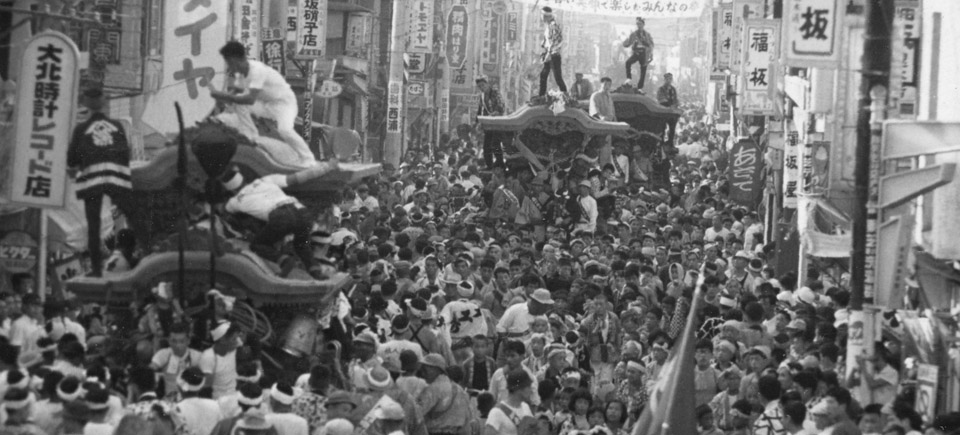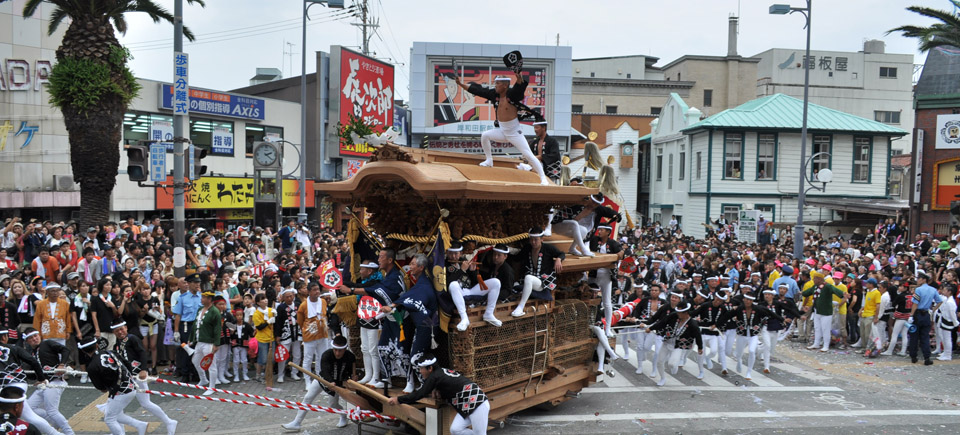Feature
Dashing Danjiri Draw Kansai Crowds
Autumn has arrived and so have the danjiri festivals in all their loud drumming, crowd-drawing, shrine-pulling glory.
Danjiri festivals are some of Japan’s most enchanting spectacles, and the most revered of them all is held just a stone’s throw away from us Kansai dwellers in the south Osaka town of Kishiwada.
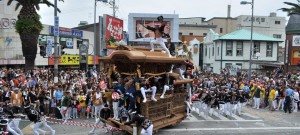 The famous Kishiwada Danjiri Matsuri dates back to 1703 when the town’s daimyo (feudal lord), Okabe Nagayasu, created a festival to pray to shinto gods for a bountiful harvest. The festival’s popularity grew rapidly as, for this short period, the otherwise strictly- prohibited locals were permitted into the castle’s grounds to drag danjiri (portable shrines) through the area. The competitive nature that spawned from attempts to outdo each other before the eyes of the daimyo has since evolved into the modern-day festival, in which armies of young men from surrounding neighborhoods heave their danjiri through the town in an exhibition of strength, agility and bravery. But what is it that makes Danjiri Matsuri unique among the thousands of festivals in the Japanese calendar?
The famous Kishiwada Danjiri Matsuri dates back to 1703 when the town’s daimyo (feudal lord), Okabe Nagayasu, created a festival to pray to shinto gods for a bountiful harvest. The festival’s popularity grew rapidly as, for this short period, the otherwise strictly- prohibited locals were permitted into the castle’s grounds to drag danjiri (portable shrines) through the area. The competitive nature that spawned from attempts to outdo each other before the eyes of the daimyo has since evolved into the modern-day festival, in which armies of young men from surrounding neighborhoods heave their danjiri through the town in an exhibition of strength, agility and bravery. But what is it that makes Danjiri Matsuri unique among the thousands of festivals in the Japanese calendar?
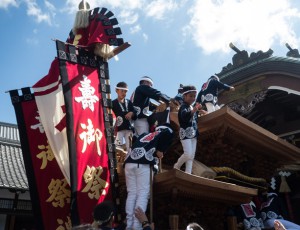 Arriving in Kishiwada at the stroke of 10am, the streets are already jam-packed with people, but luckily I manage to squeeze into a prime spot outside the station where the festival is filmed for national TV. Excitement and anticipation fills the air as well as the aroma from the myriad of street vendors selling everything from Indian cuisine to Brazilian barbecue to the staple Kansai treats okonomiyaki and takoyaki. The danjiri have been touring other parts of town since 6am when the hiki-dashi, or “opening pull”, signalled the beginning of the festival. Now, the hayashi; the drum and flute music played on the floats, echoes from out of sight, growing ever louder to signal their imminent arrival to the main street.
Arriving in Kishiwada at the stroke of 10am, the streets are already jam-packed with people, but luckily I manage to squeeze into a prime spot outside the station where the festival is filmed for national TV. Excitement and anticipation fills the air as well as the aroma from the myriad of street vendors selling everything from Indian cuisine to Brazilian barbecue to the staple Kansai treats okonomiyaki and takoyaki. The danjiri have been touring other parts of town since 6am when the hiki-dashi, or “opening pull”, signalled the beginning of the festival. Now, the hayashi; the drum and flute music played on the floats, echoes from out of sight, growing ever louder to signal their imminent arrival to the main street.
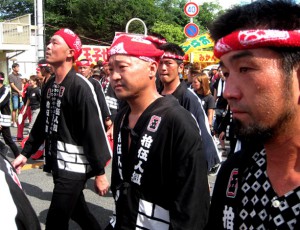 The crowd erupts as the first of many danjiri comes into view, lugged by dozens of men dressed immaculately in their troop’s traditional uniform. The floats themselves are four-ton colossal works of art made exclusively of keiyaki (zelkova) wood and interestingly, without the use of a single nail. Each group’s danjiri is adorned with carvings called horimono which depict scenes from historical battles and add further to their majestic beauty. But just as I find myself getting lost in the intricate patterns, I’m snapped out of it by the intensified beating of taiko (drums). The action is about the begin. The troop stops and the ropes used to haul the floats become taut and the ubiquitous chanting loudens. Suddenly, in an explosion of flutes and cheers the danjiri is pulled to running speed and made to skid around the corner; the man on the float’s roof, the daiku-gata, jumps and dances athletically while desperately trying not to lose balance and fall to his death like some have in years past.
The crowd erupts as the first of many danjiri comes into view, lugged by dozens of men dressed immaculately in their troop’s traditional uniform. The floats themselves are four-ton colossal works of art made exclusively of keiyaki (zelkova) wood and interestingly, without the use of a single nail. Each group’s danjiri is adorned with carvings called horimono which depict scenes from historical battles and add further to their majestic beauty. But just as I find myself getting lost in the intricate patterns, I’m snapped out of it by the intensified beating of taiko (drums). The action is about the begin. The troop stops and the ropes used to haul the floats become taut and the ubiquitous chanting loudens. Suddenly, in an explosion of flutes and cheers the danjiri is pulled to running speed and made to skid around the corner; the man on the float’s roof, the daiku-gata, jumps and dances athletically while desperately trying not to lose balance and fall to his death like some have in years past.
This exhilarating performance is repeated as different troops parade along the main street, looking increasingly exhausted as the sweltering day draws on. At this point I took the opportunity to talk with Masaharu Ishikawa, a veteran of the Nimura troop in Takaishi City’s festival. He talks about what danjiri events mean to their participants:
“I have pride in my danjiri group because we represent my hometown, Higashi Hagoromo. My uncle, cousin and best friends are all in the same group and it’s this sense of camaraderie that makes danjiri very important to us. I’m sure other groups feel the same way, but I think my group is the best and the most fun.”
Masaharu reveals that troops begin training twice a week in the months before the festival, increasing their regime to a gruelling 1-3 hours of running and pulling practice every day in the final few weeks.
“Turning corners is especially exhausting and it takes a lot of practice, but it’s worth it because the festival is so exciting! Afterwards, all the girls want to take pictures with us and at night my group and I barbecue together.”
As day turns to night the festival does indeed grow more benign. The pace slows as the danjiri are embellished with lanterns and coaxed through the streets in a procession resembling a Disneyland parade. The mobile shrines are then parked together for everyone to admire closely, the hiyashi music still whistling tenderly in the background as the stars of the show take a well-deserved rest. The dazzling Kishiwada Danjiri Matsuri is over for another year, but not to worry, because luckily Kansai is awash with danjiri festivals throughout October that, although not quite as famous as this one, make up for in convenience what they lack in size. Forget about arriving early for a spot or having to fight through a sea of people to get to a food stall. These later festivals are ideal for a more laid-back weekend jaunt where one can still experience danjiri at its truest, just in a more intimate atmosphere.
[box]
Upcoming Danjiri Festivals:
Kishiwada City
What to expect: Kishiwada’s more spiritual danjiri festival. Exhibits 47 floats as opposed to the September festival’s 34. Oct 11 (6-10pm), Oct 12 (7- 10pm)
Access: Around Kumeda, Shimomatsu and Higashi Kishiwada Stns on the JR Hanwa line
Takaishi City
What to expect: A more grassroots danjiri festival with less TV cameras and more of a homely vibe. Oct 11 (2-5pm), Oct 12 (9-11am, 1-5pm)
Access: Nankai Line, Takaishi Stn, East Exit
Sakai City
What to expect: Similarly underpublicised when compared to Kishiwada’s matsuri, experience the pride and passion of the people of Sakai. Oct 3, 5,11 & 12 (afternoonevening) Access: With so many shrines along these routes, the best bet is to get to JR Sakai Stn and follow the crowds to the nearby viewing spots.
Nada no Kenka “fighting” Danjiri festival, Himeji City
What to expect: If Kishiwada’s festival is dangerous then this is outright carnage. Watch as the different troops ferociously clash their danjiri together. Fight on! Oct 11 & 12 (all day)
Access: Matsubara Hachiman Shrine; 3-min walk from Shirahamanomiya Stn on the Sanyo Dentetsu honsen line
[/box]
だんじりが関西を曳いて走る
秋がやってきた。だんじりの季節だ。賑やかな鳴り物、揃いの衣装、勇壮な曳 行に酔いしれよう。
数ある日本の祭のなかでも、屈指の壮観を誇る のが大阪南部の泉州地域で開催される「だん じり祭」である。いちばん有名な岸和田市のだ んじり祭は、関西の居住者なら誰でも簡単に訪 れることができるビッグイベントだ。
岸和田だんじり祭の起源は、1703年にまで さかのぼる。和泉岸和田藩主岡部長泰が、岸 和田城内の伏見稲荷大社で五穀豊穣を祈願 する稲荷祭をおこなった。立ち入り厳禁だった 城内で神輿を曳きずる面白さが市民が受け、 祭は急速に人気を博すことになる。藩主の眼 前で他の町会を打ち負かす闘争心が、だんじ り祭を現代にまで受け継ぐ原動力となった。地 域に住む大勢の若者たちが、それぞれの町会 のだんじり(地車)を曳きずり、腕力や走力や 勇気を誇示しながら通りを駆けまわる。日本で は年間に数千種類もの祭がおこなわれている が、だんじり祭がこれほどまでに愛される理由 はなんだろう。
午前10時ちょうどに岸和田に着くと、通りに はもう人波が溢れている。駅を出てすぐ、国営 放送局が撮影地点に使う絶好の場所に、運よく 陣取ることができた。興奮と期待が、町の空気 に立ち込めている。インド料理やブラジル風串 焼き肉、さらには関西定番のお好み焼きやたこ 焼きまで、屋台で売られるさまざまな食べ物の 匂いが漂う。祭は朝6時の「曳き出し」で幕を開 け、だんじりはもう町中を練り歩いている。笛 や太鼓の鳴り物がどこからともなく聞こえてき て、徐々に音が大きくなってきた。だんじりが近 づき、いよいよ表通りへ現れる瞬間を、観衆は 息を呑んで待ち構えている。
揃いの衣装に身を包んだ人々に曳かれ、最 初のだんじりが姿を見せると、観衆の熱狂は一 気に爆発する。だんじりはケヤキ材で造られた 重さ4トンの巨大な神輿で、釘を1本も使用して いない芸術作品だ。歴史的な合戦を題材にした 「彫り物」で美しく飾られている。その精巧な 彫刻に目を奪われるのもつかの間、大きな太鼓 の音に度肝を抜かれた。さあ、ついに祭本番の 火蓋が切って落とされる。隊列が足を止め、曳 き綱が張り詰め、曳き唄の声が大きくなった。 笛の音と歓声が入り交じるなか、おもむろにだ んじりが曳かれ、走る速さまで一気にスピード を上げて曲がり角に突入する。屋根の上に乗っ た「大工方」が優雅に舞っている。過去に命を 落とした者たちの二の舞いとならないよう、必 死にバランスをとりながら。
さまざまな町会のだんじりが、この勇壮な パフォーマンスを表通りで繰り返す。気温が 上がってくると、曳き手には徐々に疲れの色 がにじんできた。地元の参加者にとって、だん じりはどんな意味があるのだろう。高石だんじ り祭に参加している石川さんに話を聞くこと ができた。
「生まれ育った東羽衣の象徴でもある、自 分の町会のだんじりに誇りを持っています。伯 父、従兄弟、仲間たちもみな同じ町会で、この 仲間意識があるからこそのだんじり祭です。他 の地域の人たちもみな気持ちは同じだと思い ますが、やはり自分たちの町会が最高ですね」
祭の前月になると週2回の練習が始まり、 内容は徐々に厳しさを増してくる。最後の数週 間は、1~3時間の走り込みとだんじり曳きの 練習が毎日おこなわれるのだと石川さんは教 えてくれた。
「曲がり角のやりまわしがいちばん大変で、 何度も練習が必要なところです。祭は本当に楽 しいので、厳しい練習でも報われますね。祭り の後には女の子たちがみんな一緒に写真を撮 りたがるし、夜になれば仲間たちと一緒に美味 しい串焼きを囲みます」
日が暮れて夜になると、この荒々しい祭も穏 やかな表情を見せてくれる。提灯で飾られただ んじりが、賞賛の眼差しを浴びながらメインスト リートをゆっくり進む。この「灯入れ曳行」は、ま るでディスニーランドのパレードのようだ。だん じりは一堂に会して、誰でも近くからその優美 な姿が観察できる。祭の主役たちにようやく勇 者の休息が与えられるときも、町には楽しげな お囃子がずっと流れている。
今年もまた岸和田だんじり祭は華々しく幕 を閉じ、来年の開催を待つのみとなった。だが 幸運なことに、関西では他にもたくさんのだん じり祭が10月中に開催される。知名度や規模 は岸和田に及ばないが、それを十分に埋め合 わせるほどの手軽さが魅力だ。場所取りのた めに早朝から出かけたり、大勢の人混みを押し のけて屋台に殺到したりする必要もない。この ページで紹介する各地の祭は、ゆったりとした 休日の小旅行に最適である。ひときわ親密な 雰囲気の中で、ぜひ本物のだんじり祭を体験 してみよう。
*正確な数は特定できないものの、1898年以 降に40名以上がだんじり祭で亡くなったと言 われている。


